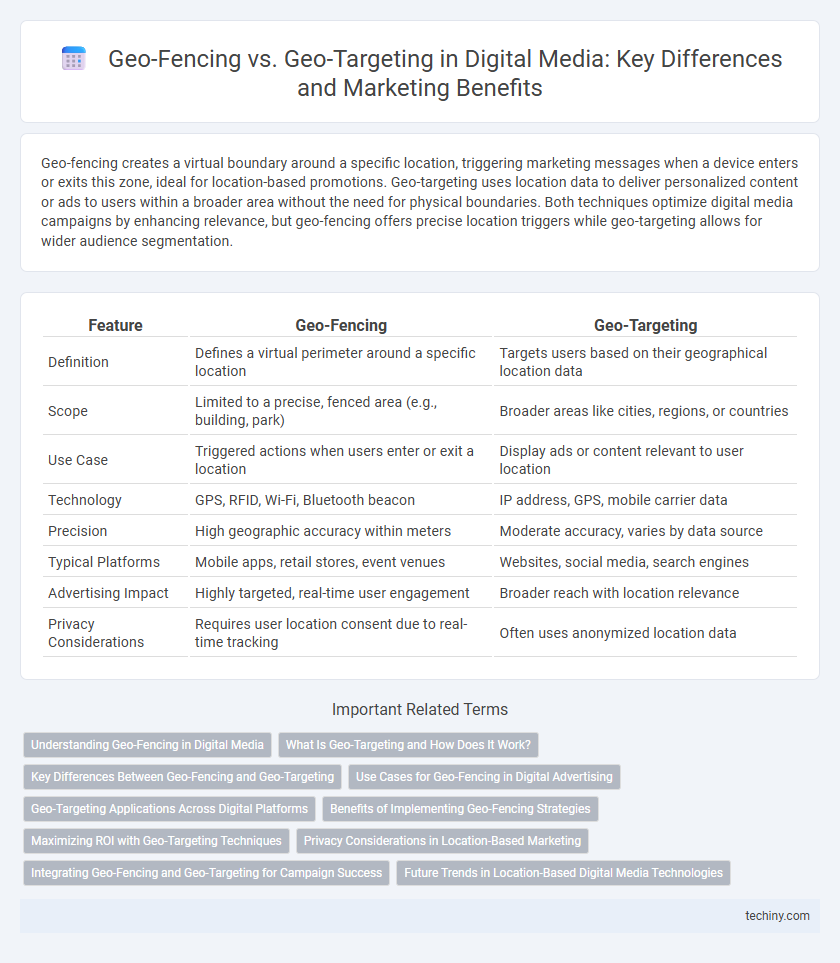Geo-fencing creates a virtual boundary around a specific location, triggering marketing messages when a device enters or exits this zone, ideal for location-based promotions. Geo-targeting uses location data to deliver personalized content or ads to users within a broader area without the need for physical boundaries. Both techniques optimize digital media campaigns by enhancing relevance, but geo-fencing offers precise location triggers while geo-targeting allows for wider audience segmentation.
Table of Comparison
| Feature | Geo-Fencing | Geo-Targeting |
|---|---|---|
| Definition | Defines a virtual perimeter around a specific location | Targets users based on their geographical location data |
| Scope | Limited to a precise, fenced area (e.g., building, park) | Broader areas like cities, regions, or countries |
| Use Case | Triggered actions when users enter or exit a location | Display ads or content relevant to user location |
| Technology | GPS, RFID, Wi-Fi, Bluetooth beacon | IP address, GPS, mobile carrier data |
| Precision | High geographic accuracy within meters | Moderate accuracy, varies by data source |
| Typical Platforms | Mobile apps, retail stores, event venues | Websites, social media, search engines |
| Advertising Impact | Highly targeted, real-time user engagement | Broader reach with location relevance |
| Privacy Considerations | Requires user location consent due to real-time tracking | Often uses anonymized location data |
Understanding Geo-Fencing in Digital Media
Geo-fencing in digital media creates virtual boundaries using GPS or RFID technology to trigger targeted advertisements or notifications when users enter specific geographic areas. This technique enables highly localized marketing campaigns, increasing relevance and engagement by delivering content based on a user's real-time location. Geo-fencing differs from geo-targeting by focusing on proximity-triggered interactions rather than broader location-based audience segmentation.
What Is Geo-Targeting and How Does It Work?
Geo-targeting is a digital marketing strategy that delivers content to users based on their geographic location through IP addresses, GPS data, or device settings. It works by identifying specific locations such as cities, regions, or countries and tailoring advertisements, offers, or messages relevant to that area's demographics and preferences. This precise targeting enhances user engagement, improves ad relevance, and maximizes campaign effectiveness in digital media.
Key Differences Between Geo-Fencing and Geo-Targeting
Geo-fencing creates a virtual perimeter around a specific location to trigger ads or notifications when users enter or exit the area, while geo-targeting focuses on delivering content based on a user's geographic location without predefined boundaries. Geo-fencing operates with precise location triggers using GPS or RFID technology, whereas geo-targeting utilizes broader location data such as IP addresses or mobile carrier information. The key difference lies in geo-fencing's real-time, location-based engagement versus geo-targeting's general regional customization for audience segmentation.
Use Cases for Geo-Fencing in Digital Advertising
Geo-fencing is widely used in digital advertising to deliver hyper-localized promotions and real-time offers to consumers within a specific geographic perimeter, such as targeting shoppers near a retail store or event venue. Retailers utilize geo-fencing to drive foot traffic by sending personalized notifications and discounts when potential customers enter a defined zone, enhancing in-store engagement and sales. This technology is also effective for event marketing, enabling advertisers to reach attendees on-site with relevant content while optimizing ad spend by restricting campaigns to precise locations.
Geo-Targeting Applications Across Digital Platforms
Geo-targeting enhances digital marketing by delivering location-specific content across platforms like social media, search engines, and mobile apps, increasing engagement and conversion rates. Applications include personalized ads on Facebook and Google Ads, localized promotions in mobile push notifications, and targeted content on streaming services. This precision ensures advertisers reach relevant audiences, maximizing campaign effectiveness and ROI.
Benefits of Implementing Geo-Fencing Strategies
Geo-fencing enhances digital media campaigns by delivering hyper-localized content to users within a predefined virtual boundary, increasing relevance and engagement rates significantly. This strategy enables precise tracking of consumer behavior patterns and foot traffic, facilitating data-driven marketing decisions that improve ROI. Implementing geo-fencing also supports real-time notifications and promotions, boosting immediate customer interaction and brand responsiveness.
Maximizing ROI with Geo-Targeting Techniques
Geo-targeting leverages precise user location data to deliver tailored digital media content, significantly enhancing engagement rates and maximizing ROI. Unlike geo-fencing, which confines messaging within rigid virtual boundaries, geo-targeting dynamically adjusts campaigns based on real-time user behavior and preferences. Implementing advanced geo-targeting algorithms enables brands to optimize ad spend by reaching high-intent audiences, driving higher conversion rates and improved campaign performance.
Privacy Considerations in Location-Based Marketing
Geo-fencing and geo-targeting utilize location data to deliver personalized digital media content, but they differ in privacy implications. Geo-fencing creates a virtual boundary around a specific area, triggering ads when users enter that zone, which requires precise location tracking and may raise privacy concerns related to real-time data collection. Geo-targeting targets users based on broader geographic regions, offering less intrusive data use and typically adhering more easily to privacy regulations like GDPR and CCPA.
Integrating Geo-Fencing and Geo-Targeting for Campaign Success
Integrating geo-fencing and geo-targeting maximizes campaign precision by combining location-based barriers with targeted audience segmentation. Geo-fencing triggers real-time, location-specific engagement when users enter predefined virtual boundaries, while geo-targeting delivers personalized ads based on users' geographic data across broader regions. Leveraging both strategies enhances digital media campaigns with hyper-local relevance and broader demographic reach, driving higher conversion rates and improved ROI.
Future Trends in Location-Based Digital Media Technologies
Advancements in digital media are rapidly enhancing geo-fencing and geo-targeting capabilities by integrating AI and machine learning for real-time audience analysis and hyper-personalized content delivery. Emerging trends indicate a shift towards seamless cross-device location tracking and augmented reality experiences, creating immersive, context-aware marketing strategies. The future of location-based digital media technologies promises increased accuracy, privacy compliance, and dynamic consumer engagement driven by 5G connectivity and edge computing innovations.
Geo-Fencing vs Geo-Targeting Infographic

 techiny.com
techiny.com